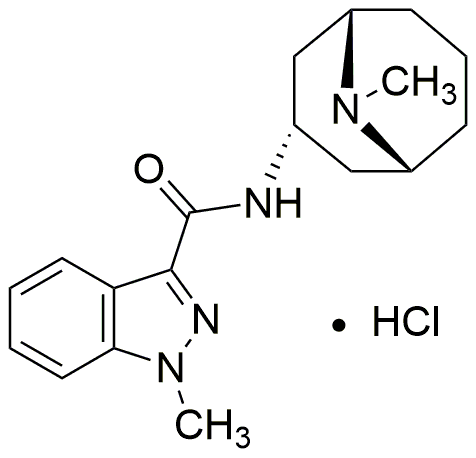Granisetron hydrochloride is widely utilized in research focused on:
- Anti-Nausea Treatments: It is primarily used in oncology to prevent nausea and vomiting caused by chemotherapy, providing relief for patients undergoing cancer treatment.
- Postoperative Care: This compound is effective in managing postoperative nausea and vomiting, improving recovery experiences for patients after surgery.
- Clinical Trials: Researchers often use it in clinical studies to evaluate its effectiveness and safety in various patient populations, contributing to advancements in medical protocols.
- Formulation Development: Granisetron hydrochloride is employed in the development of oral and injectable formulations, allowing for flexible administration routes tailored to patient needs.
- Comparative Studies: It serves as a benchmark in studies comparing new antiemetic drugs, helping to establish efficacy and safety profiles against existing treatments.
General Information
Properties
Safety and Regulations
Applications
Granisetron hydrochloride is widely utilized in research focused on:
- Anti-Nausea Treatments: It is primarily used in oncology to prevent nausea and vomiting caused by chemotherapy, providing relief for patients undergoing cancer treatment.
- Postoperative Care: This compound is effective in managing postoperative nausea and vomiting, improving recovery experiences for patients after surgery.
- Clinical Trials: Researchers often use it in clinical studies to evaluate its effectiveness and safety in various patient populations, contributing to advancements in medical protocols.
- Formulation Development: Granisetron hydrochloride is employed in the development of oral and injectable formulations, allowing for flexible administration routes tailored to patient needs.
- Comparative Studies: It serves as a benchmark in studies comparing new antiemetic drugs, helping to establish efficacy and safety profiles against existing treatments.
Documents
Safety Data Sheets (SDS)
The SDS provides comprehensive safety information on handling, storage, and disposal of the product.
Product Specification (PS)
The PS provides a comprehensive breakdown of the product’s properties, including chemical composition, physical state, purity, and storage requirements. It also details acceptable quality ranges and the product's intended applications.
Certificates of Analysis (COA)
Search for Certificates of Analysis (COA) by entering the products Lot Number. Lot and Batch Numbers can be found on a product’s label following the words ‘Lot’ or ‘Batch’.
*Catalog Number
*Lot Number
Certificates Of Origin (COO)
This COO confirms the country where the product was manufactured, and also details the materials and components used in it and whether it is derived from natural, synthetic, or other specific sources. This certificate may be required for customs, trade, and regulatory compliance.
*Catalog Number
*Lot Number
Safety Data Sheets (SDS)
The SDS provides comprehensive safety information on handling, storage, and disposal of the product.
DownloadProduct Specification (PS)
The PS provides a comprehensive breakdown of the product’s properties, including chemical composition, physical state, purity, and storage requirements. It also details acceptable quality ranges and the product's intended applications.
DownloadCertificates of Analysis (COA)
Search for Certificates of Analysis (COA) by entering the products Lot Number. Lot and Batch Numbers can be found on a product’s label following the words ‘Lot’ or ‘Batch’.
*Catalog Number
*Lot Number
Certificates Of Origin (COO)
This COO confirms the country where the product was manufactured, and also details the materials and components used in it and whether it is derived from natural, synthetic, or other specific sources. This certificate may be required for customs, trade, and regulatory compliance.


